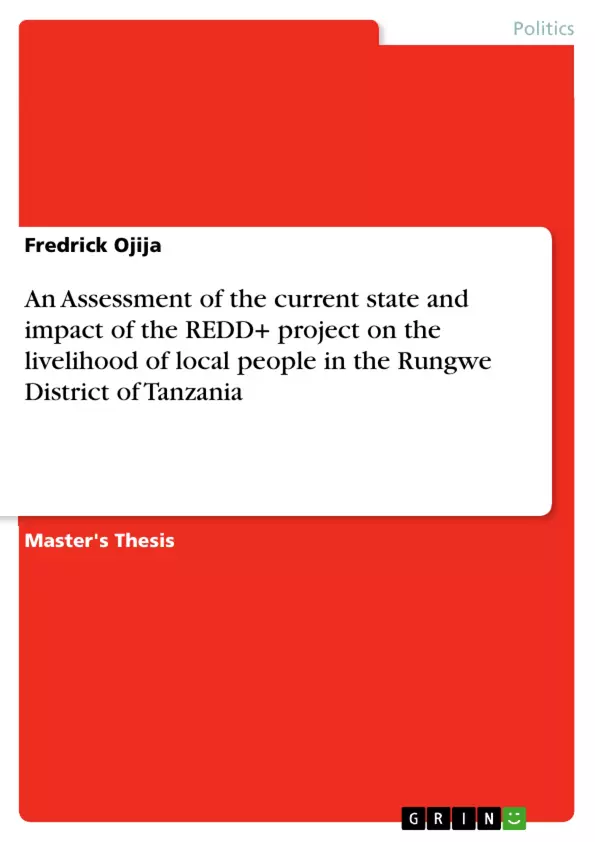A climate change mitigation mechanism, Reducing Emission from Deforestation and forest Degradation (REDD+) is anticipated to affect livelihoods of forest dependent communities. This study was conducted to establish this impact on livelihoods of local people in Rungwe District, Tanzania. Data were collected through questionnaires, group discussions, and interviews from three villages: Syukula, Ilolo and Kibisi.
Results showed that households’ annual income and crop production are higher after REDD+ implementation. The older respondents (>40 years old) considered REDD+ to be important for forest management compared to younger generation (<40 years old) (p<0.05). Similarly, the older respondents considered wood forest products such as fuelwood, charcoal, timber and poles to be reduced.
There was a widespread awareness about REDD+’s objectives among household respondents. Therefore, REDD+ proponents should implement alternative sources of livelihoods to help local people improve their income and reduce dependence on the forest resources and eventually decrease deforestation and forest degradation.
Inhaltsverzeichnis (Table of Contents)
- ACKNOWLEDGEMENTS
- LIST OF FIGURES
- LIST OF TABLES
- LIST OF ABREVIATIONS
- ABSTRACT
- 1. INTRODUCTION
- 1.1. REDD+: current state of affairs
- 1.1.1. Objective and evolution of REDD+
- 1.1.2. Readiness for REDD+
- 1.1.3. Current status and obstacles of REDD+ implementation
- 1.1.4. Tanzania REDD+ Initiatives: institutional structure and reporting
- 1.2. Forest management and status in Tanzania
- 1.2.1. Tanzania country facts
- 1.2.2. Forest policy, land use and management in Tanzania
- 1.2.3. Forest types in Tanzania
- 1.2.4. Problem statement and justification
- 2. OBJECTIVES
- 2.1. General objective
- 2.2. Specific objectives
- 2.3. Research questions
- 3. MATERIALS AND METHODS
- 3.1. Description of the study area
- 3.1.1. Geographical location
- 3.1.2. Climate, Soil and Geology
- 3.1.3. Fauna and flora
- 3.1.4. Population
- 3.2. Research methodology
- 3.2.1. Household survey questionnaires
- 3.2.2. Focus group discussion
- 3.2.3. Interviews, field observations and literature review
- 3.3. Data analysis
- 4. RESULTS
- 4.1. Composition of household respondents in the study villages
- 4.2. Occupations and sources of income and energy of household respondents
- 4.3. Households' awareness, perception and willingness (or readiness) for REDD+
- 4.4. Impact of REDD+ project on income, fuelwoods, charcoal and building materials of households in the study villages
- 4.5. Impact of REDD+ project on households' annual crop production in the study villages
- 4.6. Relationship between households' income and crop production
- 5. DISCUSSION
- 5.1. Composition of household respondents in the study villages
- 5.2. Households' occupation and main sources of income and energy
- 5.3. Households' awareness, perception and willingness for REDD+
- 5.4. Impact of REDD+ project on households' income, crop production, fuelwood, charcoal and building materials
- 6. CONCLUSION AND RECOMMENDATION
- 6.1. Conclusion
- 6.2. Recommendations and Future perspectives
- 7. REFERENCES
- The current state and implementation of REDD+ in Tanzania.
- The impact of REDD+ on the livelihoods of local communities in Rungwe District.
- The awareness, perception, and willingness of local communities towards REDD+.
- The relationship between REDD+ and income, fuelwood use, and crop production.
- Recommendations for improving the implementation of REDD+ in Tanzania.
Zielsetzung und Themenschwerpunkte (Objectives and Key Themes)
This thesis examines the current state and impact of REDD+ on the livelihoods of local people in Rungwe District, Tanzania. The study aims to assess the awareness, perception, and willingness of local communities towards REDD+ and to evaluate its influence on income, fuelwood use, and agricultural production.
Zusammenfassung der Kapitel (Chapter Summaries)
The first chapter introduces the concept of REDD+, outlining its objectives, evolution, and current status, including the challenges faced in its implementation. It also provides an overview of forest management practices in Tanzania and the specific context of Rungwe District.
The second chapter outlines the research objectives and questions that guide the study, focusing on the assessment of REDD+'s impact on local communities' livelihoods in Rungwe District.
The third chapter delves into the methodology employed in the research, including a description of the study area, the research methods used, and the data analysis techniques employed.
The fourth chapter presents the results of the study, providing detailed information on the composition of household respondents, their occupations and sources of income, their awareness and perception of REDD+, and the impact of the project on their income, fuelwood use, and agricultural production.
The fifth chapter discusses the findings presented in the previous chapter, analyzing the implications of the results for the understanding of REDD+'s impact on local communities.
Schlüsselwörter (Keywords)
This thesis focuses on REDD+, its implementation in Tanzania, and the impact on local communities' livelihoods. Key concepts include awareness, perception, willingness, income, fuelwood use, agricultural production, forest management, and sustainable development. The research investigates the relationship between REDD+ and local communities, seeking to understand the implications of the project for their lives and livelihoods. The study highlights the importance of community involvement and engagement in the implementation of REDD+ and other conservation initiatives.
- Citation du texte
- Fredrick Ojija (Auteur), 2014, An Assessment of the current state and impact of the REDD+ project on the livelihood of local people in the Rungwe District of Tanzania, Munich, GRIN Verlag, https://www.grin.com/document/314593



